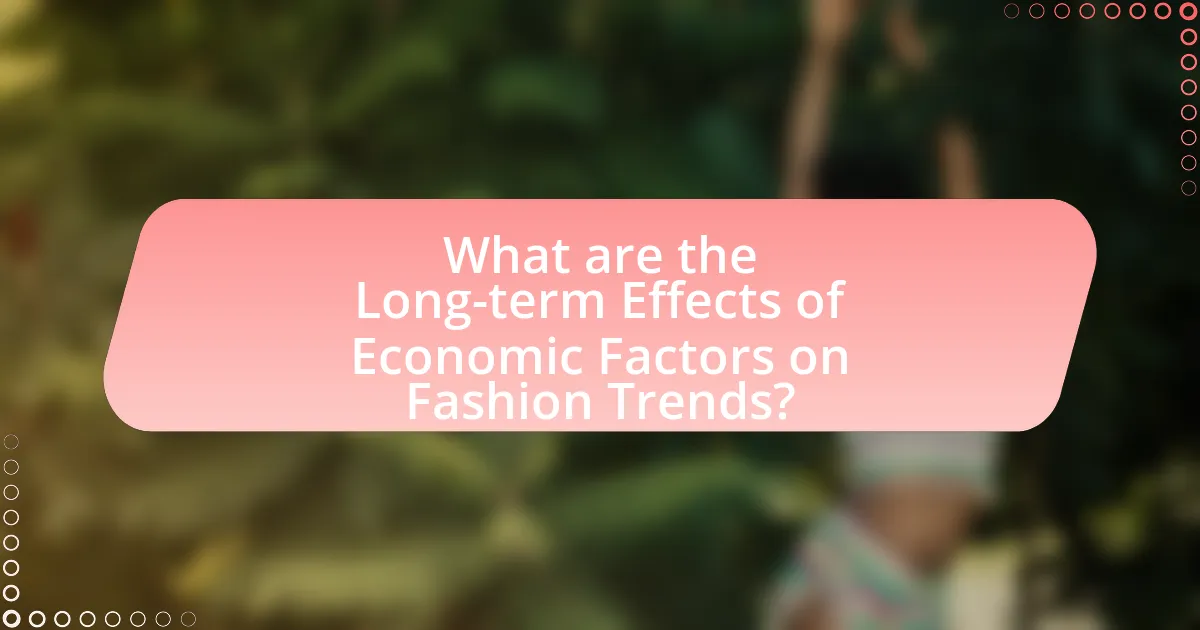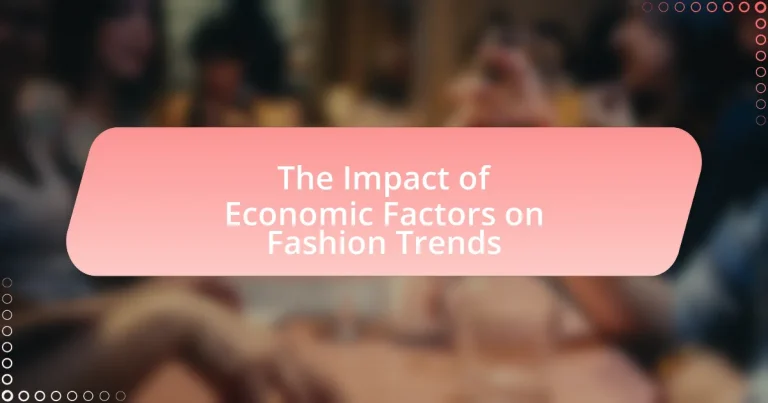The article examines the impact of economic factors on fashion trends, highlighting how consumer income levels, economic stability, and global trade dynamics shape purchasing behavior and brand strategies. It discusses the influence of disposable income on fashion choices, the effects of economic downturns on consumer behavior, and the role of global economic conditions in determining market demand. Additionally, the article explores how exchange rates, inflation, and employment rates affect pricing strategies and consumer confidence in fashion spending. It concludes by addressing the long-term effects of economic factors on sustainability trends and consumer preferences in the fashion industry.

What are the Economic Factors Influencing Fashion Trends?
Economic factors influencing fashion trends include consumer income levels, economic stability, and global trade dynamics. Higher disposable income typically leads to increased spending on fashion, while economic downturns can result in reduced consumer spending and a shift towards more affordable options. For instance, during the 2008 financial crisis, luxury fashion brands experienced a significant decline in sales as consumers prioritized essential goods over discretionary spending. Additionally, global trade policies and tariffs can affect the cost of materials and production, impacting pricing strategies and ultimately shaping fashion trends. For example, changes in trade agreements can lead to fluctuations in the availability and cost of textiles, influencing designers’ choices and consumer offerings.
How do consumer spending habits affect fashion trends?
Consumer spending habits significantly influence fashion trends by dictating demand for specific styles, brands, and products. When consumers prioritize spending on fashion, designers and retailers respond by creating collections that align with current preferences, often leading to the emergence of new trends. For instance, during economic booms, increased disposable income typically results in a surge in luxury fashion purchases, which can set trends that emphasize opulence and exclusivity. Conversely, during economic downturns, consumers may shift towards more affordable, sustainable, or minimalist fashion options, prompting brands to adapt their offerings accordingly. This cyclical relationship is evidenced by data from the U.S. Bureau of Economic Analysis, which shows that retail sales in clothing and accessories often correlate with overall consumer confidence and spending levels.
What role does disposable income play in fashion choices?
Disposable income significantly influences fashion choices by determining the amount of money consumers can allocate to clothing and accessories. Higher disposable income allows individuals to purchase more expensive, trendy, or luxury items, while lower disposable income restricts choices to more affordable options. According to a report by Statista, in 2021, consumers in the United States with higher disposable income spent approximately 30% more on apparel compared to those with lower income levels. This correlation illustrates that as disposable income increases, so does the likelihood of purchasing fashionable and high-quality items, thereby shaping overall fashion trends.
How do economic downturns influence consumer behavior in fashion?
Economic downturns lead consumers to prioritize essential purchases over discretionary spending, significantly impacting the fashion industry. During such periods, consumers often shift towards budget-friendly brands and second-hand shopping, as evidenced by a 2020 McKinsey report indicating that 60% of consumers planned to reduce their spending on non-essential items. Additionally, economic uncertainty drives a preference for timeless, versatile pieces rather than trendy items, as consumers seek to maximize value and longevity in their purchases. This behavior reflects a broader trend where economic conditions directly shape consumer priorities and spending habits in the fashion sector.
What impact do global economic conditions have on fashion trends?
Global economic conditions significantly influence fashion trends by affecting consumer spending power and shaping market demand. During economic downturns, consumers tend to prioritize essential purchases over luxury items, leading to a rise in demand for affordable and practical fashion. For instance, the 2008 financial crisis resulted in a notable shift towards fast fashion brands, as consumers sought lower-priced alternatives. Conversely, in periods of economic growth, there is an increased willingness to spend on high-end and designer items, reflecting a trend towards luxury fashion. This correlation between economic conditions and consumer behavior is supported by data from the Global Fashion Agenda, which indicates that economic stability directly impacts retail sales and brand strategies in the fashion industry.
How do exchange rates affect the pricing of fashion items?
Exchange rates significantly influence the pricing of fashion items by affecting the cost of imported goods and the competitiveness of local brands. When a country’s currency weakens against others, imported fashion items become more expensive, leading retailers to raise prices to maintain profit margins. For instance, a 10% depreciation of the euro against the dollar can increase the cost of European fashion brands in the U.S. market, prompting price adjustments. Conversely, a stronger currency can lower import costs, allowing retailers to offer more competitive pricing. Historical data shows that fluctuations in exchange rates can lead to price changes of up to 20% in the fashion sector, directly impacting consumer purchasing behavior and overall market dynamics.
What is the relationship between inflation and fashion purchasing trends?
Inflation negatively impacts fashion purchasing trends by reducing consumers’ disposable income, leading to decreased spending on non-essential items like clothing. As inflation rises, consumers prioritize essential goods and services, resulting in a decline in demand for fashion products. For instance, during periods of high inflation, such as the 1970s in the United States, fashion retailers reported significant drops in sales as consumers faced increased prices for basic necessities. This trend indicates that as inflation persists, consumers are likely to shift towards budget-friendly options or delay purchases, affecting overall fashion market dynamics.
How do employment rates influence fashion industry dynamics?
Employment rates significantly influence fashion industry dynamics by affecting consumer spending power and demand for fashion products. Higher employment rates typically lead to increased disposable income, allowing consumers to spend more on clothing and accessories. For instance, during periods of low unemployment, such as the U.S. economy’s recovery post-2008 financial crisis, retail sales in the fashion sector saw substantial growth, with a reported increase of 4.2% in clothing sales in 2015 alone. Conversely, high unemployment rates can lead to decreased consumer confidence and spending, resulting in lower sales for fashion brands. This relationship underscores the direct impact of employment levels on the overall health and trends within the fashion industry.
What is the effect of unemployment on luxury fashion sales?
Unemployment negatively impacts luxury fashion sales, as higher unemployment rates lead to decreased disposable income and consumer spending. For instance, during the 2008 financial crisis, luxury goods sales dropped significantly, with a reported decline of 10% in the global luxury market due to rising unemployment and economic uncertainty. This trend indicates that as more individuals face job loss, their ability to purchase high-end fashion items diminishes, resulting in lower sales for luxury brands.
How does job security impact consumer confidence in fashion spending?
Job security significantly enhances consumer confidence in fashion spending. When individuals feel secure in their employment, they are more likely to allocate disposable income towards discretionary purchases, including fashion items. For instance, a study by the Bureau of Labor Statistics indicates that during periods of low unemployment, consumer spending in the retail sector, particularly in fashion, tends to increase, reflecting a direct correlation between job security and spending behavior. This relationship underscores how stable employment conditions foster a positive outlook on financial stability, leading to increased investment in fashion consumption.

How do Economic Factors Shape Fashion Industry Strategies?
Economic factors significantly shape fashion industry strategies by influencing consumer purchasing power, market demand, and production costs. For instance, during economic downturns, consumers tend to prioritize essential goods over luxury items, prompting fashion brands to adjust their offerings towards more affordable and practical designs. Additionally, fluctuations in raw material prices can lead to changes in production strategies, as brands may seek cost-effective alternatives or adjust their supply chains to maintain profitability. Historical data shows that during the 2008 financial crisis, many fashion retailers shifted focus to value-oriented products, which resulted in a surge in fast fashion brands that catered to budget-conscious consumers. This adaptability to economic conditions is crucial for sustaining market relevance and competitiveness in the fashion industry.
What strategies do fashion brands employ during economic fluctuations?
Fashion brands employ various strategies during economic fluctuations to maintain profitability and market relevance. These strategies include adjusting pricing models, enhancing value propositions, and diversifying product lines. For instance, during economic downturns, brands often implement discounting strategies or introduce lower-priced collections to attract cost-conscious consumers. Additionally, brands may focus on promoting quality and sustainability to justify higher price points, appealing to consumers’ desire for long-lasting products. Historical data shows that during the 2008 financial crisis, many luxury brands shifted to more accessible price points, which helped them retain customer loyalty and market share. Furthermore, brands may also increase their online presence and invest in digital marketing to reach a broader audience, as seen in the rise of e-commerce during economic challenges.
How do brands adjust pricing strategies in response to economic changes?
Brands adjust pricing strategies in response to economic changes by analyzing market conditions, consumer behavior, and cost structures. For instance, during economic downturns, brands may lower prices or offer discounts to maintain sales volume and attract price-sensitive consumers. Conversely, in a thriving economy, brands might increase prices to enhance profit margins, reflecting higher demand and consumer willingness to spend. Historical data shows that during the 2008 financial crisis, many fashion brands implemented aggressive discounting strategies, resulting in a 20% increase in sales for those that adapted quickly. This demonstrates that timely adjustments to pricing can significantly impact a brand’s performance in fluctuating economic environments.
What marketing tactics are used to attract consumers in tough economic times?
During tough economic times, businesses often employ value-driven marketing tactics to attract consumers. These tactics include offering discounts, emphasizing quality and durability, and promoting essential products over luxury items. For instance, retailers may implement loyalty programs or bundle offers to provide perceived savings, which can increase consumer interest and drive sales. Research indicates that during economic downturns, consumers prioritize value, leading to a shift in marketing strategies that focus on affordability and practicality. According to a study by McKinsey & Company, 75% of consumers are more price-sensitive during economic crises, reinforcing the effectiveness of these tactics.
How do economic factors influence fashion supply chains?
Economic factors significantly influence fashion supply chains by affecting production costs, consumer demand, and pricing strategies. For instance, fluctuations in raw material prices, such as cotton or synthetic fibers, directly impact manufacturing expenses, which can lead to changes in product pricing. Additionally, economic conditions like inflation or recession influence consumer purchasing power, thereby affecting demand for fashion items. According to a report by McKinsey & Company, during economic downturns, consumers tend to prioritize essential goods over luxury fashion, leading to reduced sales for high-end brands. Furthermore, exchange rate variations can affect international sourcing and distribution, as brands may face increased costs when importing materials or products. These economic dynamics shape how fashion companies manage their supply chains to remain competitive and responsive to market changes.
What are the effects of economic conditions on sourcing and production?
Economic conditions significantly influence sourcing and production by affecting costs, availability of materials, and labor dynamics. For instance, during economic downturns, companies often face increased material costs and reduced access to suppliers, leading to higher production expenses. Conversely, in a robust economy, sourcing can become more competitive, allowing companies to negotiate better terms and access a wider range of materials. Additionally, fluctuations in currency exchange rates can impact international sourcing, as seen in the 2008 financial crisis, which caused many brands to reassess their supply chains due to rising costs and instability in supplier countries. These economic factors directly shape production strategies and sourcing decisions in the fashion industry.
How do tariffs and trade policies impact fashion supply chains?
Tariffs and trade policies significantly impact fashion supply chains by altering costs and accessibility of materials and labor. When tariffs are imposed on imported textiles or finished garments, the increased costs can lead to higher retail prices, affecting consumer demand. For instance, the U.S.-China trade war resulted in tariffs that raised costs for many fashion brands, forcing them to reconsider sourcing strategies and potentially shift production to countries with lower tariffs. Additionally, trade policies can influence the speed and efficiency of supply chains; restrictive policies may lead to delays in shipping and increased lead times, disrupting the timely delivery of products to market. These dynamics illustrate how tariffs and trade policies directly affect the operational decisions of fashion companies, ultimately shaping market trends and consumer behavior.

What are the Long-term Effects of Economic Factors on Fashion Trends?
Long-term economic factors significantly shape fashion trends by influencing consumer purchasing power, production costs, and market demand. For instance, during economic recessions, consumers tend to prioritize essential goods over luxury items, leading to a rise in minimalist and sustainable fashion trends. Historical data from the 2008 financial crisis shows a marked shift towards affordable and versatile clothing, as brands like H&M and Zara thrived by offering budget-friendly options. Additionally, inflation affects the cost of raw materials, which can lead to increased prices for consumers and a shift in brand strategies towards more sustainable practices. This trend is supported by a 2021 McKinsey report indicating that 67% of consumers are willing to pay more for sustainable fashion, reflecting a long-term shift in consumer values influenced by economic conditions.
How do economic trends shape consumer preferences in fashion over time?
Economic trends significantly shape consumer preferences in fashion by influencing purchasing power and spending behavior. For instance, during economic downturns, consumers tend to prioritize affordability and practicality, leading to a rise in demand for budget-friendly brands and second-hand clothing. Conversely, in periods of economic growth, consumers often exhibit a preference for luxury and high-end fashion, as seen in the increase of sales for premium brands during the economic boom of the late 1990s and early 2000s. Additionally, economic factors such as inflation and unemployment rates directly impact consumer confidence, which in turn affects their willingness to spend on fashion items. For example, a study by McKinsey & Company in 2021 highlighted that 66% of consumers changed their shopping habits due to economic uncertainty, favoring brands that offered value and sustainability. Thus, economic trends play a crucial role in shaping the evolving landscape of consumer preferences in the fashion industry.
What lasting changes have occurred in fashion due to past economic crises?
Economic crises have led to lasting changes in fashion, primarily characterized by a shift towards minimalism, sustainability, and the rise of fast fashion. During the Great Depression, for instance, consumers favored simpler, more practical clothing, which influenced designers to create less ornate styles. This trend towards minimalism has persisted, as seen in the modern preference for versatile, timeless pieces that emphasize functionality over extravagance.
Additionally, economic downturns have heightened awareness of sustainability in fashion. The 2008 financial crisis prompted consumers to reconsider their purchasing habits, leading to a demand for ethically produced and environmentally friendly clothing. This shift has resulted in the growth of sustainable fashion brands and a focus on circular fashion practices, such as recycling and upcycling.
Moreover, the rise of fast fashion brands, which emerged in response to economic pressures, has fundamentally altered the fashion landscape by making trendy clothing more accessible and affordable. This model has created a culture of rapid consumption, which continues to influence consumer behavior today.
These changes reflect a direct response to economic challenges, demonstrating how crises can reshape fashion trends and consumer priorities in lasting ways.
How do economic factors influence sustainability trends in fashion?
Economic factors significantly influence sustainability trends in fashion by dictating consumer purchasing power and shaping industry practices. For instance, during economic downturns, consumers often prioritize affordability over sustainability, leading to increased demand for fast fashion, which typically has a lower environmental impact. Conversely, in times of economic growth, consumers may be more willing to invest in sustainable brands, as evidenced by a 2021 McKinsey report indicating that 67% of consumers consider sustainability when making purchasing decisions. Additionally, economic incentives, such as government subsidies for sustainable practices or taxes on carbon emissions, can encourage fashion companies to adopt eco-friendly methods, thereby aligning profitability with sustainability goals.
What lessons can fashion brands learn from economic impacts on trends?
Fashion brands can learn to adapt their strategies based on economic conditions, as consumer spending patterns directly influence trends. For instance, during economic downturns, consumers tend to prioritize value and practicality, leading to a rise in demand for affordable and versatile clothing. This was evident during the 2008 financial crisis when fast fashion brands like H&M and Zara thrived by offering trendy yet budget-friendly options. Additionally, brands should monitor economic indicators such as unemployment rates and inflation, as these factors can predict shifts in consumer behavior and preferences. By aligning their product offerings with the economic climate, fashion brands can better meet consumer needs and sustain their market relevance.
How can brands prepare for future economic shifts in the fashion industry?
Brands can prepare for future economic shifts in the fashion industry by adopting a flexible supply chain and diversifying their product offerings. A flexible supply chain allows brands to quickly adapt to changes in consumer demand and economic conditions, as evidenced by companies like Zara, which utilizes a just-in-time production model to respond rapidly to market trends. Diversifying product offerings can mitigate risks associated with economic downturns; for instance, brands that expand into sustainable fashion or athleisure have seen growth even during economic challenges, as these segments often remain resilient. Additionally, investing in data analytics can help brands forecast trends and consumer behavior more accurately, enabling proactive adjustments to their strategies.
What practical strategies can consumers adopt in response to economic factors affecting fashion?
Consumers can adopt several practical strategies in response to economic factors affecting fashion, such as prioritizing quality over quantity, shopping during sales, and exploring second-hand options. Prioritizing quality ensures that consumers invest in durable items that provide better long-term value, especially during economic downturns when disposable income may be limited. Shopping during sales events, which have been shown to increase significantly during economic recessions, allows consumers to acquire fashionable items at reduced prices. Additionally, exploring second-hand options, which have gained popularity with a 27% increase in thrift shopping reported in recent years, enables consumers to find unique pieces while being budget-conscious. These strategies help consumers navigate economic challenges while maintaining their fashion sense.


